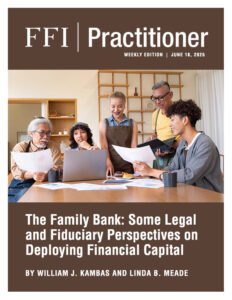
View this edition in our enhanced digital edition format with supporting visual insight and information.
Thanks to William J. Kambas and Linda B. Meade for this article, the second of a periodic series of issues dedicated to topics related to private trust companies. Today’s article addresses a strategic tool available to family enterprises and their advisors with consolidated financial capital: The Family Bank. The focus of this article is on the more formalized approach to the family bank and provides insights for advisors and their clients who decide to establish a private family bank entity.1
(Please note that this article is based generally on US law and is presented as an example that may be useful in other jurisdictions worldwide.)2
What Is a Family Bank?
A family bank is not a traditional financial institution but rather a structured approach to centralizing and deploying a family’s financial capital and credit within a family enterprise. It is also an opportunity to encourage financial education about investment and governance principles. Typically, a private entity that consolidates financial capital, a “family bank” provides structured lending and investment opportunities to family members while supporting ventures, education, and other initiatives that align with the family’s long-term mission and values. Family banks could potentially make loans, guarantees, or advances that may not be available through lenders or may be considered higher risk by commercial lenders and thus would come with less favorable terms.
Some of the benefits of a family bank include:
- Encouraging Entrepreneurship and Development: Deploy capital to help launch new ventures and foster professional experience and success for individual family members.
- Financial Education and Responsibility: Serve as a practical learning ground for younger generations, teaching responsible borrowing, financial planning, and accountability through formal application processes and repayment obligations.
- Supporting Family Goals: Strategically deploy capital for purposes that align with the family’s values and objectives, such as homeownership.
- Fostering Family Unity: Provide family members with another opportunity to work together, communicate effectively, and overcome obstacles in furtherance of a mutually beneficial goal.
It is important to keep in mind that a family bank is not a guaranteed pool of money available to any family member at any time for any purpose3 but rather operates as part of a viable family enterprise where funding could be formally applied for and reviewed under specified criteria. However, for family enterprises that include a family office and/or trust company, the power and flexibility of introducing a formal family bank entity can come hand-in-hand with significant fiduciary responsibilities. The trustees, directors, and executives overseeing a family bank must carefully navigate and balance their professional duties and complex family dynamics. Failure to uphold these duties can lead to financial liability, regulatory scrutiny, and, perhaps most damagingly, intra-family conflict.
Key Fiduciary Duties and Challenges
The fiduciary responsibilities of those tasked with overseeing a family bank include the following:
- Duty of Loyalty: Fiduciaries must act in the best interest of the beneficiaries of the family bank structure. This is complicated by the conflicts of interest inherent in family banks. Some of the family bank fiduciaries may be family members themselves, potentially benefiting directly or indirectly from lending decisions or facing pressure from relatives. This complexity underscores the value of having independent fiduciaries in place to help prioritize the family bank’s long-term health and fairness to all beneficiaries over individual desires or relationships.
- Duty of Care: This duty involves a standard of good faith and reasonable diligence, prudence, and competence. Fiduciaries must ensure that the family bank entity operates within legal and ethical boundaries, carefully assessing the risks associated with loans or investments made through the family bank. This requires establishing and following reasonable underwriting processes, performing appropriate due diligence on family borrowers and their plans, determining collateral requirements (if any), and actively managing the loan portfolio. Simply approving requests without any diligence or processes in place may breach this duty.
- Duty of Impartiality: Fiduciaries must balance the often-competing interests of current and future family members, e.g., current borrowers vs. future generations who rely on capital preservation, or siblings with opposing demands for resource allocation. Fiduciaries should use care to create reasonable guidelines and policies to help ensure family bank decisions are perceived as fair across different family branches or generations, as further discussed below.
- Duty of Confidentiality: Family bank fiduciaries will have access to sensitive financial and personal information of the family members. Safeguarding this confidentiality is essential to maintaining the family bank’s integrity and the family members’ trust.
Suggestions for Family Bank Fiduciaries
To successfully navigate these complexities and mitigate fiduciary risk, family advisors would be wise to encourage their clients to adopt the following:
- Develop a Family Bank Governance System: Develop a clear family bank governance system that provides guidelines and protocols regarding decision-making, loan review criteria and processes, conflict resolution, and communication among the fiduciaries and family members. The family bank could be overseen by a board of directors, officers, and/or advisory committee. Independent committee members may help in managing potential family conflicts. The board and committee(s) should have clear rules in place outlining their responsibilities and protocols. Frameworks should be designed to specifically define loan eligibility criteria and loan application and review processes.
- Establish Formal Documentation: Ensure formal documentation is in place. The family bank should have governing documents that define eligible borrowers, permissible loan purposes, loan limits, interest rate policies (ensuring all loans are made at or above the Applicable Federal Rate (AFR)), and conflict-of-interest procedures. The family bank might also have a mission statement that outlines the family bank’s objectives and serves as a guiding framework for the fiduciaries and family members. The board of directors, officers, and committee(s) should have formal written rules in place governing their meetings and decision-making processes, and any meetings and decisions should be documented in writing in accordance with these rules. The loan process should involve a standardized loan application, agreed-upon due diligence checklists, formal promissory notes, and meticulous record-keeping for all stages including application, review, approval/denial rationale, funding, servicing, and collection efforts.
- Respect Tax and Legal Considerations: Fiduciaries should consult with tax and estate planning advisors to ensure that all loans are made in accordance with prevailing jurisdictional tax guidelines and are thus respected as bona fide loans. Loans should be properly documented with a promissory note, as discussed above, to avoid the risk of the loan being recharacterized as a gift. All loans should contain an interest rate at or above the AFR in effect at the time the loan is made. Formalities should be respected and followed, including making interest and principal payments in accordance with the terms of the promissory note and reporting the receipt of interest or original issue discount (OID) income.
- Leverage Professional Expertise: Fiduciaries should consult and rely upon experienced external advisors, including legal, tax, and investment professionals, as needed, to ensure the structure remains compliant, tax-efficient, and aligned with evolving laws and best practices regarding fiduciary duties and intra-family lending.
- Facilitate Regular Reviews: A family bank should undertake regular, periodic reviews of its policies and operations, as well as the loan portfolio’s performance, to ensure they are aligned with the family’s evolving needs and changing market conditions. Changes in family structure and dynamics due to death, marriages, divorces, and births may necessitate updates to the family bank’s policies regarding decision-making, asset protection, and income and estate tax considerations. By making sure the family bank is flexible and responsive to the family’s changing needs and goals, fiduciaries can help ensure the family bank remains beneficial, effective, and relevant.
Conclusion
Family banks, when thoughtfully implemented, can serve as efficient and effective vehicles for preserving and growing both family wealth and well-being. However, family banks require appropriate structure and oversight in order to fully serve their intended purposes. The success of a family bank is thus enhanced by establishing clear governance, embracing independent oversight where appropriate, maintaining rigorous processes, and fostering transparent communication. Families and their advisors can harness the benefits of a family bank while safeguarding assets, mitigating risk, and preserving family harmony.
References
1 The choice of entity for a family bank can range from a simple corporation, limited partnership, limited liability company (LLC) or trust to a more complex structure involving multiple entities, depending on the particular needs of a family.
2 The article is informed by a recent case, Estate of Barbara Galli v. Commissioner (Tax Court, March 5, 2025).
3 Kirby Rosplock, The Complete Family Office Handbook: A Guide for Affluent Families and the Advisors Who Serve Them, 2nd ed. (Wiley, 2021), 337.
DISCLAIMER: The views expressed in this article are those of the authors only. The information contained in this article is provided solely for informational purposes. This article does not constitute legal or tax advice or create an attorney-client relationship.
About the Contributors

William J. Kambas is a partner on the private client and tax team at Withers Bergman. He focuses on tax planning for multi-national and multi-state personal, active business, and investment activities. Bill’s practice assists families and family offices with the formation, management, and evaluation of centralized control and management structures. https://www.withersworldwide.com/en-gb/people/william-kambas

Linda B. Meade is a senior associate in the private client and tax team of Withers Bergman LLP. She advises US and non-US families, business owners, and investors on structuring, tax, and compliance matters, with an emphasis on the formation and administration of single-family offices and private trust companies. https://www.withersworldwide.com/en-gb/people/linda-meade

View this edition in our enhanced digital edition format with supporting visual insight and information.





